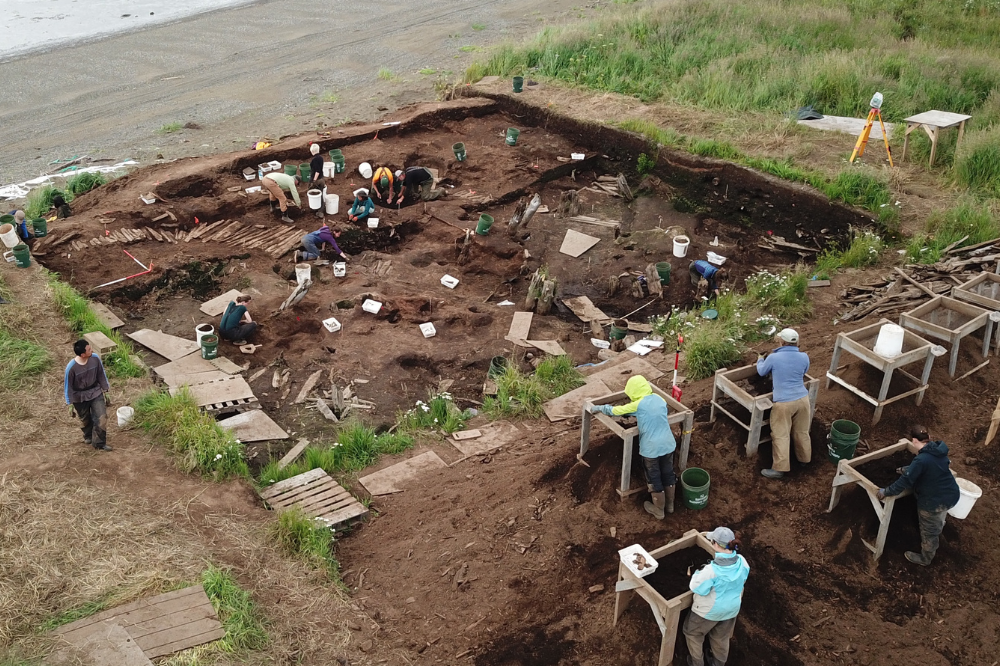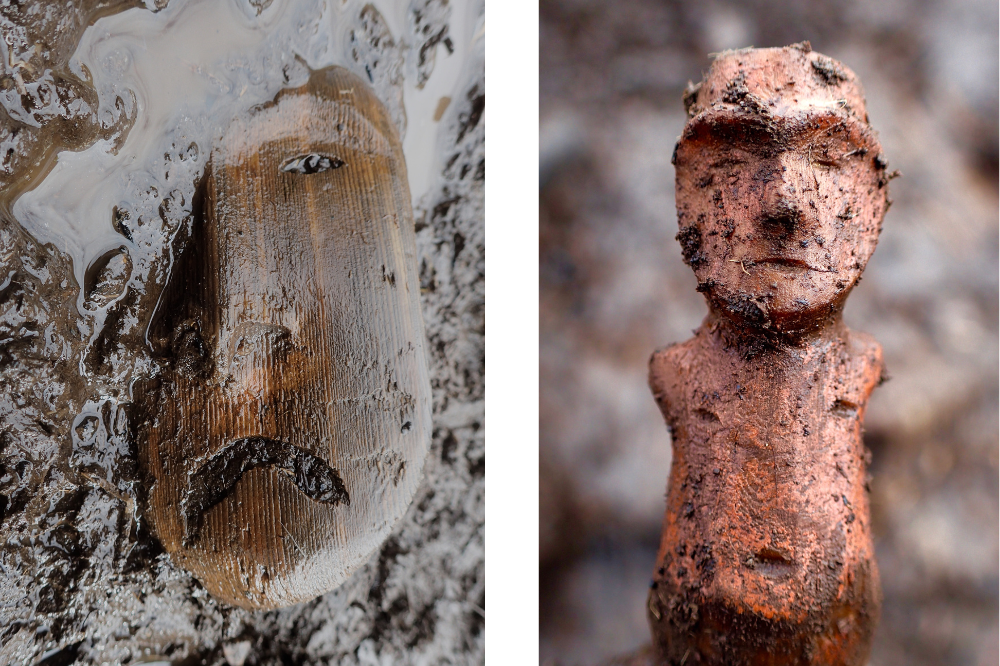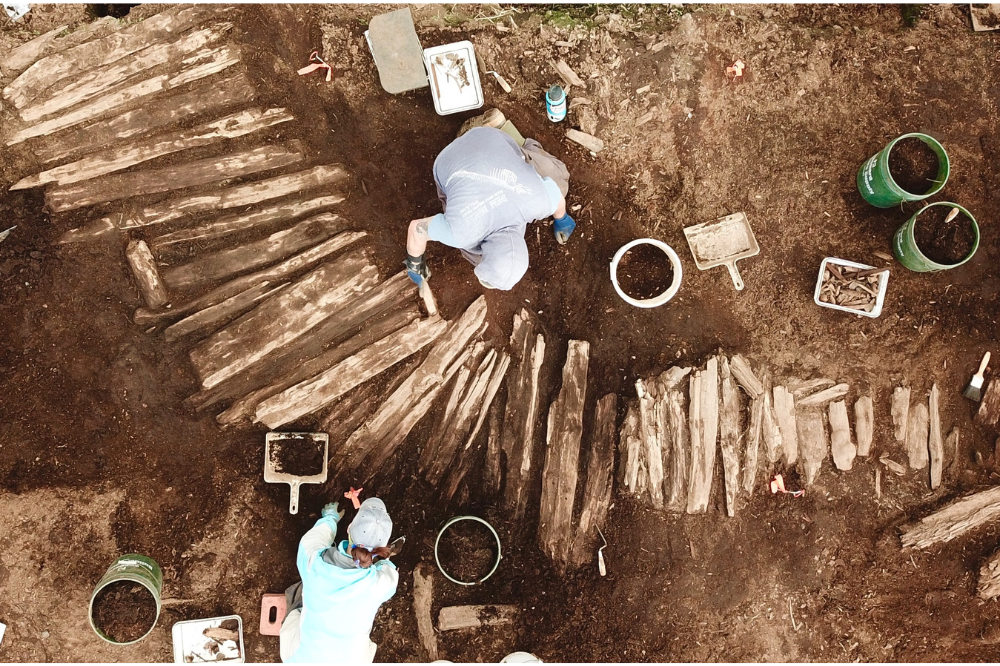Yup’ik resilience in southwestern Alaska

The Nunalleq Archaeological Site in Alaska
By Claire Houmard
100,000 artifacts discovered in a few square feet of space. This is the extraordinary result of archaeological excavations conducted on the southwest coast of Alaska for the past 13 years, at Nunalleq, on the Bering Sea. Nunalleq has become a reference point when it comes to telling the story of the Yup’ik past, which has lived there for centuries. It is also the history of this resilient people in the face of climatic catastrophes that is being written before our eyes, and that is at the center of a five-year residency undertaken by French archeologist Claire Houmard with Villa Albertine.
Many, if not all, Arctic societies are currently affected by climate change. Climate change is resulting in increased temperatures, melting permafrost, rising seas, and more intense weather events that increase coastal erosion. Communities must be resilient in the face of these social and climatic changes. This resilience can be enforced by a reaffirmation of their identity and an increased focus on their tangible and intangible heritage. The “Yup’ik” research that we are proposing aims to compare the past and present resilience of this population settled on the southwestern coast of Alaska.

It all started with a wooden doll lying on a beach near Quinhagak in 2007. An archaeological site, known for a long time by oral tradition, was becoming threatened by coastal erosion. With each fall storm, the coastline receded further and the beach became covered with archaeological remains. Warren Jones, the director of Qanirtuuq Inc., the village ANCSA (The Alaska Native Claims Settlement Act) corporation, felt that something had to be done and called on the archaeologist Rick Knecht who, since 2009, has taken charge of saving the site. Named Nunalleq, “the old village” by local Elders, this legacy of a 400 years old past has proven to be an extremely rich site both in terms of the material culture it has yielded (more than 100,000 artifacts), but also in terms of its spiritual imprint (several hundred masks and human figures made of wood).
Nunalleq bears witness to a double tragedy. The first and most recent, is linked to the rapid and destructive consequences of the current climate change marked by the melting of the permafrost that fixed the soil, and the intensification of violent meteorological phenomena, notably autumn storms. The area most threatened by coastal erosion, excavated in 2009 and 2010, no longer exists, it has been washed away by the sea. The second tragedy, an old one, which cause the abandonment of the site around 1675, is the deadly conflicts that plagued the region during the Little Ice Age (1350-1900). Access to resources, made increasingly difficult by climatic cooling, probably led to an increase in armed conflicts for the defense of the most strategic territories for the subsistence of these maritime populations. Legend has it that a play accident between two children was the spark that ignited the spirit of revenge and triggered the event known as the “Bow and Arrows War”.
Nevertheless, this site was a place of active life before being a place of memory. It shows evidence of numerous activities, both material and spiritual. Relatively sedentary and hierarchical, this society lived essentially from salmon fishing, sea mammal hunting and caribou hunting, even if other species were also exploited (birds, small land mammals). At least eight generations followed one another on the same place within about 200 years, with some architectural changes. The craft of driftwood, and to a lesser extent caribou antler and walrus ivory, is particularly developed. History often retains only the significant facts, thus masking the small stories of daily life. It is the role of the archaeologists to bring them to light and to rewrite these forgotten parts of History.
Through the rich material culture it has yielded during the excavation campaigns conducted by the University of Aberdeen between 2009 and 2018, Nunalleq has become the reference for narrating the Yup’ik past. After a pause, partly imposed by the Covid-19 pandemic, the archaeological excavations will resume in the framework of a cooperation with the French Ministry of Europe and Foreign Affairs, and the Villa Albertine. We wish to contribute to the preservation of this exceptional tangible and intangible heritage which has earned Nunalleq a place on the National Geographic’s list of the 100 Wonders of the World and as one of the “100 Discoveries That Changed the World” in the book Lost Cities, Ancient Tombs directed by Ann Williams. Among the ongoing and future projects are the monograph of the first ten years of excavations by Rick Knecht; the constitution of a virtual museum with the involvement of the residents of Quinhagak led by Charlotta Hillerdal and Alice Watterson; the search for new sites by Jonathan Lim, Edouard Masson-MacLean and the French YUP’IK project; and finally, the continuation of the archaeological excavations at Nunalleq by Claire Houmard with the support of Rick Knecht.
This site of past life that is Nunalleq has provided, over the years, a new element of cohesion and cultural dynamics within the village of Quinhagak. A close collaboration between the village residents, Elders and cultural bearers and university archaeologists has made it possible to safeguard the site. Conceived jointly by Rick Knecht and Warren Jones, the idea of building a Nunalleq Museum was born, in order to retain the artifacts within the village itself. While archaeological objects very often end up in “sanctuaries” (museums) far from the places where they were discovered, the choice was made to maintain the tangible and intangible cultural knowledge in the descendant community so that the local population can remain the guardians of its heritage. This is an important issue since the village and the Nunalleq Culture and Archaeology Center are still threatened by rising waters and are likely to be moved in the medium term.

Nevertheless, symbolically, it seemed essential for this community and for the archaeologists who contributed to the safeguarding of its heritage to maintain it on its ancestral lands for as long as possible. This new place of memory had the positive effect of reviving the pride of being Yup’ik among the young people, brought traditional dancing back to the village, wanted to learn the language of their ancestors again, and volunteered both for the excavation and for the treatment and conditioning of the remains after their discovery. The village of Quinhagak has the unique opportunity to reconcile past and present and to contribute to a (re)valorization of the Yup’ik cultural identity. Populations that still have substance-based livelihoods, such as the Yupiit (plural of Yup’ik) communities, which are largely traditional, are particularly threatened by the context of economic globalization and climate change that we are currently experiencing.
Rather than simply observing the dramatic effects of current climate disturbances, the residents of Quinhagak have turned a weakness into a strength by taking some of their destiny into their own hands. While it is not always possible to fight the current natural upheavals, the threat of rising seas and coastal erosion should not prevent us from being proactive and resilient. Combining the past with the present and learning from History to make the most of it and not repeat the same mistakes is a major universal issue that the residents of Quinhagak, in their own way, hope to address successfully. Their initiative is beginning to be noticed and is of interest to other villages in the surrounding area.
The Villa Albertine in New York, in partnership with the World Monuments Fund (WMF), will welcome Claire Houmard on March 27 at 6pm for the first Heritage Speaks devoted to an in-depth look at the rapid climate-induced erosion destroying the Nunalleq archaeological site in Alaska. You can follow the discussions by registering for the event (by clicking here) or join the live on our youtube channel !
